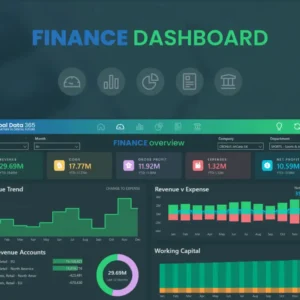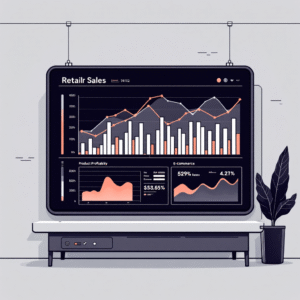What is Power BI and Why is it Used? Complete Guide 2025
Table of Contents
What is Power BI?
Power BI is Microsoft's flagship business intelligence (BI) and data analytics platform that empowers organizations to transform raw data into meaningful insights through interactive visualizations and comprehensive reporting. Launched in 2011 and continuously evolved, Power BI has become one of the leading self-service business intelligence tools in the market, serving millions of users worldwide across various industries and organizational sizes.
At its core, Power BI is designed to democratize data analytics, enabling business users without extensive technical backgrounds to create sophisticated reports, dashboards, and data models. The platform seamlessly integrates with Microsoft's ecosystem while also supporting connections to hundreds of external data sources, making it a versatile solution for modern data-driven organizations.
The platform operates on a simple yet powerful principle: collect data from various sources, transform and model it according to business requirements, and present it through compelling visualizations that drive informed decision-making. This approach has revolutionized how businesses handle their data analytics needs, shifting from traditional IT-dependent reporting to self-service analytics that empowers every user in the organization.
Need Expert Power BI Implementation?
Transform your data into actionable insights with our professional Power BI services. Get personalized consultation and implementation support.
Contact us: info@powerbigate.com | Call: +1 281 631 3767
Key Components of Power BI
Power BI Desktop
The primary development environment where users create reports, build data models, and design visualizations. It's a free Windows application that provides comprehensive data modeling capabilities.
Power BI Service
The cloud-based platform (PowerBI.com) where users publish, share, and collaborate on reports and dashboards. It enables real-time data refresh and enterprise-level sharing capabilities.
Power BI Mobile
Mobile applications for iOS, Android, and Windows devices that allow users to access dashboards and reports on-the-go with touch-optimized interfaces.
Power BI Report Server
On-premises reporting solution for organizations requiring data to remain within their own infrastructure, providing hybrid deployment options.
Why Businesses Use Power BI
Data-Driven Decision Making
In today's competitive business landscape, organizations that leverage data effectively gain significant advantages over their competitors. Power BI enables businesses to move beyond gut-feeling decisions to evidence-based strategies. By providing real-time access to key performance indicators (KPIs), trends, and patterns, Power BI empowers decision-makers at all levels to respond quickly to market changes, identify opportunities, and mitigate risks before they become critical issues.
Cost-Effective Business Intelligence
Traditional business intelligence solutions often required significant upfront investments in hardware, software licenses, and specialized personnel. Power BI disrupts this model by offering enterprise-grade analytics capabilities at a fraction of the cost. With pricing starting at $10 per user per month, organizations can deploy comprehensive BI solutions without the traditional barriers to entry, making advanced analytics accessible to small and medium-sized businesses.
Power BI Adoption Growth Chart
| Year | Active Users (Millions) | Growth Rate | Market Share |
|---|---|---|---|
| 2019 | 1.5 | - | 8% |
| 2020 | 2.3 | 53% | 12% |
| 2021 | 3.2 | 39% | 16% |
| 2022 | 4.1 | 28% | 20% |
| 2023 | 5.0 | 22% | 24% |
Enhanced Operational Efficiency
Power BI streamlines reporting processes that traditionally consumed countless hours of manual work. Automated data refresh, standardized templates, and self-service capabilities reduce the burden on IT departments while enabling business users to generate insights independently. This efficiency gain translates to cost savings and allows teams to focus on strategic initiatives rather than routine reporting tasks.
Core Features and Capabilities
Data Connectivity and Integration
Power BI's strength lies in its ability to connect to virtually any data source. Whether your data resides in cloud-based services like Salesforce and Google Analytics, on-premises databases like SQL Server and Oracle, or simple Excel files, Power BI provides native connectors that simplify the integration process. The platform supports real-time streaming data, scheduled refresh, and hybrid connectivity options to meet diverse organizational needs.
Advanced Data Modeling
Power BI incorporates a sophisticated data modeling engine based on Microsoft's proven Analysis Services technology. Users can create relationships between tables, define calculated columns and measures using DAX (Data Analysis Expressions), and implement row-level security to control data access. The modeling capabilities support complex business logic while maintaining optimal query performance.
| Feature | Power BI Pro | Power BI Premium | Power BI Premium Per User |
|---|---|---|---|
| Data Model Size | 1 GB | 400 GB | 100 GB |
| Refresh Frequency | 8 times/day | 48 times/day | 48 times/day |
| Data Flow | No | Yes | Yes |
| AI Features | Limited | Full | Full |
| Multi-geo Support | No | Yes | No |
Rich Visualization Library
Power BI offers an extensive collection of built-in visualizations ranging from standard charts and graphs to advanced custom visuals developed by the community. The platform includes geographic mapping capabilities, statistical charts, and interactive elements that enhance user engagement. Additionally, the Microsoft AppSource marketplace provides hundreds of custom visuals for specialized use cases.
Ready to Transform Your Data Strategy?
Our Power BI experts can help you unlock the full potential of your data. From implementation to advanced dashboard creation, we've got you covered.
Email: info@powerbigate.com | Phone: +1 281 631 3767
Benefits of Power BI Implementation
Improved Data Accessibility
Power BI democratizes access to organizational data by providing intuitive interfaces that business users can navigate without technical expertise. Self-service capabilities reduce dependency on IT departments, enabling faster insights generation and more agile business responses. Users can explore data independently, create ad-hoc reports, and discover trends that might otherwise remain hidden in traditional reporting systems.
Real-Time Insights and Monitoring
Modern businesses operate in real-time, and their analytics tools must keep pace. Power BI supports streaming datasets, live connections, and frequent data refresh schedules that ensure decision-makers always have access to current information. This real-time capability is particularly valuable for monitoring operational metrics, tracking campaign performance, and responding to emerging trends or issues.
Data Collection
Connect to multiple data sources simultaneously, including cloud services, on-premises databases, files, and web services.
Data Transformation
Clean, shape, and model data using Power Query and data modeling tools to ensure consistency and reliability.
Visualization Creation
Design interactive dashboards and reports that tell compelling data stories and highlight key insights.
Sharing and Collaboration
Publish reports to the Power BI service and enable secure sharing across teams, departments, and external stakeholders.
Continuous Improvement
Monitor usage patterns, gather feedback, and iterate on reports to maximize business value and user adoption.
Enhanced Collaboration and Sharing
Power BI's cloud-based architecture facilitates seamless collaboration across teams and departments. Users can share dashboards, embed reports in other applications, and control access levels to ensure appropriate data governance. The commenting and subscription features enable ongoing discussions around data insights and automated delivery of critical information to stakeholders.
Scalability and Enterprise Readiness
As organizations grow, their analytics needs evolve. Power BI scales from individual users to enterprise-wide deployments supporting thousands of users and massive datasets. Premium capacities provide dedicated resources for performance-intensive workloads, while governance features ensure compliance with organizational policies and regulatory requirements.
Real-World Use Cases
Financial Reporting and Analysis
Finance teams leverage Power BI to automate monthly reporting processes, track budget performance, and provide executive leadership with real-time financial insights. The platform's integration with ERP systems and financial databases enables comprehensive views of organizational financial health, while predictive analytics capabilities support forecasting and risk management initiatives.
Sales Performance Management
Sales organizations use Power BI to track individual and team performance against targets, analyze pipeline health, and identify trends in customer behavior. Integration with CRM systems provides comprehensive customer journey insights, while territory analysis helps optimize sales resource allocation and identify expansion opportunities.
Manufacturing Analytics
Monitor production efficiency, track quality metrics, and optimize supply chain operations through real-time manufacturing dashboards.
Marketing Campaign Analysis
Measure campaign effectiveness, track customer acquisition costs, and analyze marketing attribution across multiple channels.
HR Analytics
Track employee performance, analyze retention patterns, and optimize recruitment processes through comprehensive workforce analytics.
Customer Service Monitoring
Monitor support ticket trends, track customer satisfaction scores, and identify opportunities for service improvement.
Healthcare and Life Sciences
Healthcare organizations utilize Power BI to track patient outcomes, monitor operational efficiency, and ensure regulatory compliance. The platform's security features and compliance certifications make it suitable for handling sensitive healthcare data while providing insights that improve patient care and operational performance.
Power BI vs Other BI Tools
| Feature | Power BI | Tableau | QlikView | Looker |
|---|---|---|---|---|
| Pricing (per user/month) | $10-$20 | $35-$70 | $30-$50 | Custom |
| Learning Curve | Easy | Moderate | Steep | Moderate |
| Data Connectors | 400+ | 250+ | 200+ | 150+ |
| Cloud Integration | Excellent | Good | Limited | Excellent |
| Mobile Support | Excellent | Good | Limited | Good |
Competitive Advantages
Power BI's tight integration with the Microsoft ecosystem provides significant advantages for organizations already using Office 365, Azure, and other Microsoft services. The familiar interface reduces training time, while seamless data connectivity with Microsoft applications accelerates implementation. Additionally, Microsoft's substantial investment in AI and machine learning capabilities continues to enhance Power BI's analytical sophistication.
Getting Started with Power BI
Planning Your Implementation
Successful Power BI implementation begins with clear objectives and stakeholder alignment. Organizations should identify key business questions they want to answer, inventory available data sources, and establish governance policies for data access and sharing. A phased approach, starting with a pilot project, allows teams to build expertise while demonstrating value to the broader organization.
Essential Skills Development
While Power BI is designed for business users, developing certain skills accelerates success. Understanding basic data modeling concepts, learning DAX for calculations, and grasping visualization best practices enhance the quality and impact of reports. Microsoft provides extensive learning resources, including documentation, video tutorials, and community forums.
Building Your First Dashboard
Starting with a simple use case helps build confidence and demonstrates quick wins. Consider beginning with readily available data sources like Excel files or cloud services your organization already uses. Focus on answering specific business questions rather than creating comprehensive dashboards, then expand based on user feedback and additional requirements.
Best Practices for Power BI Success
Data Governance and Security
Establishing proper governance frameworks ensures data quality, security, and compliance. Implement row-level security to control data access, establish data refresh schedules that balance currency with system performance, and create standardized naming conventions for consistency across reports. Regular audits of sharing permissions and data source access help maintain security posture.
Performance Optimization
Power BI performance depends heavily on data model design and query optimization. Minimize data model size by importing only necessary columns and rows, use appropriate data types, and create efficient relationships between tables. Implement incremental refresh for large datasets and consider using aggregations for frequently accessed summarized data.
User Adoption Strategies
Technology adoption succeeds through user engagement and continuous value demonstration. Provide comprehensive training programs, create template libraries for common use cases, and establish power user communities within your organization. Regular feedback sessions and iterative improvements based on user input drive long-term success and expand analytical capabilities across the organization.
Conclusion
Power BI represents a transformative approach to business intelligence, democratizing data analytics and enabling organizations of all sizes to harness the power of their data. Its combination of ease-of-use, comprehensive functionality, and cost-effectiveness has made it the fastest-growing business intelligence platform in the market. As businesses increasingly recognize the competitive advantages of data-driven decision making, Power BI provides the foundation for building analytical capabilities that drive growth, efficiency, and innovation.
The platform's continuous evolution, backed by Microsoft's substantial investment in cloud technologies and artificial intelligence, ensures that Power BI will remain at the forefront of business intelligence innovation. Organizations that embrace Power BI today position themselves to benefit from ongoing enhancements while building the analytical capabilities essential for future success in an increasingly data-driven business landscape.
Whether you're a small business seeking to understand customer patterns or a large enterprise requiring comprehensive operational dashboards, Power BI offers the tools, flexibility, and scalability to meet your evolving analytical needs. The journey from data to insights has never been more accessible, making now the ideal time to begin your Power BI transformation.
Start Your Power BI Journey Today
Don't let your data remain untapped. Our certified Power BI experts are ready to help you implement a comprehensive business intelligence solution tailored to your unique needs.
Contact Information:
📧 Email: info@powerbigate.com
📞 Phone: +1 281 631 3767
Related Resources
- Essential Financial KPIs Every Power BI Dashboard Should Track
- Power BI for SaaS Companies: Complete Implementation Guide
- Power BI Metadata Management: Best Practices and Tools
- Power BI vs Excel for Financial Reporting: Which is Better?
- How to Build a CFO Executive Dashboard in Power BI (Free Template)







